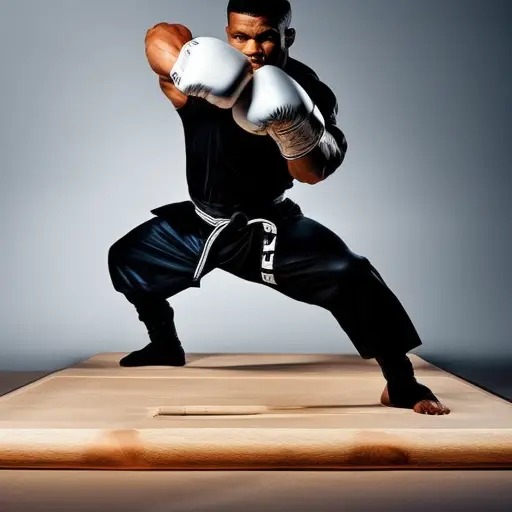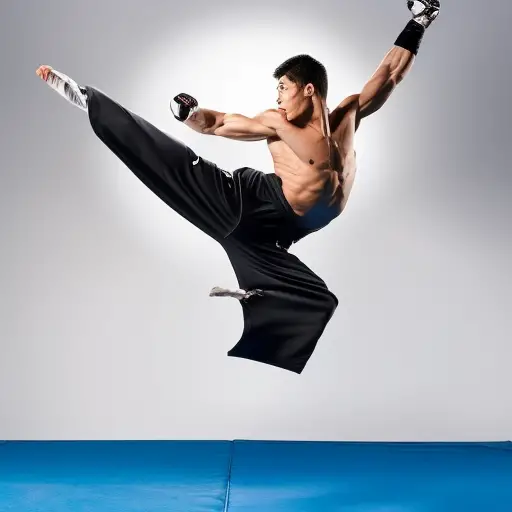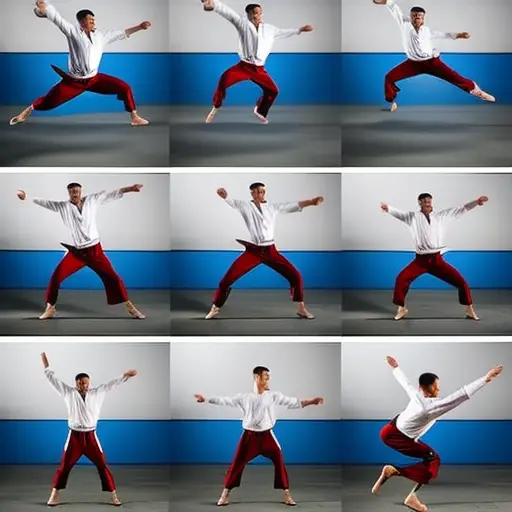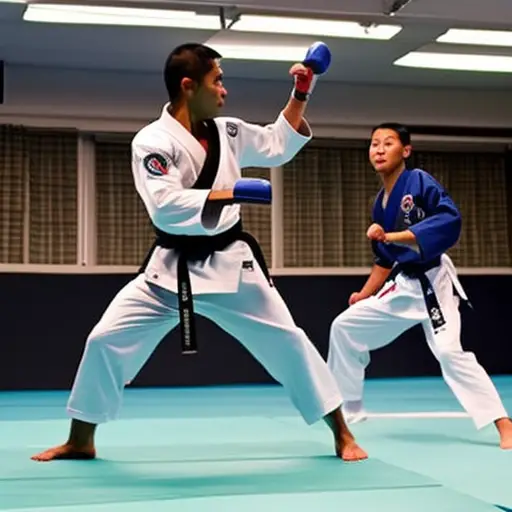The Science Behind Effective Board Breaking

In the realm of martial arts, board breaking is a physical demonstration of power and skill. However, behind this seemingly simple act lies a fascinating interplay of physics, biomechanics, and mental focus.
By understanding the science behind effective board breaking, martial artists can enhance their technique and achieve greater feats of strength.
This article delves into the intricacies of board breaking, exploring how the properties of wood, speed and acceleration, body mechanics, and mental barriers all contribute to the successful execution of this impressive martial arts technique.
The Physics of Board Breaking
The physics behind board breaking involves understanding the forces at play during the execution of a martial arts technique. When a martial artist strikes a board, the impact force is transferred to the board, causing it to break. To understand this phenomenon, it is necessary to consider the properties of concrete and the impact of temperature.
Concrete is a widely used material for board breaking due to its strength and durability. It consists of a mixture of cement, water, and aggregates such as sand and gravel. The properties of concrete, such as its density and compressive strength, play a crucial role in determining how easily it can be broken. A denser concrete will require more force to break, while a lower compressive strength will allow for easier breaking.
Temperature also affects the breaking of boards. Concrete becomes more brittle at lower temperatures, making it easier to break. On the other hand, at higher temperatures, concrete becomes more ductile and resilient, making it more difficult to break.
Understanding the properties of wood, the material used for breaking boards, is crucial in effectively executing the technique. Therefore, it is important to explore how wood behaves when subjected to impact forces, which will be discussed in the subsequent section.
Understanding the Properties of Wood
Understanding the properties of wood is crucial for effective board breaking. One key aspect to consider is the strength variations of different types of wood, as some are inherently stronger than others.
Additionally, the moisture content of the wood can greatly impact its strength and ability to break.
Lastly, choosing the right type of wood is essential, as different woods have different properties that can affect the success of the board breaking technique.
Wood’s Strength Variations
Wood exhibits a wide range of strength variations due to factors such as moisture content, grain orientation, and density. Understanding these properties is crucial for effective board breaking.
Moisture content: Wood’s strength is influenced by its moisture content. When wood is wet, it becomes softer and more pliable, making it easier to break. Conversely, dry wood is harder and more resistant to breaking.
Grain orientation: The grain structure of wood plays a significant role in its strength. Wood with straight, uniform grains is generally stronger and less prone to splitting. In contrast, wood with irregular or interlocking grains may be more challenging to break.
Density: The density of wood determines its overall strength. Dense hardwoods, such as oak or maple, are stronger and more resistant to breaking than softer woods like pine or cedar.
Moisture Content’s Impact
To fully comprehend the impact of moisture content on wood, practitioners must analyze its influence on strength and resilience.
The moisture content of wood refers to the amount of water present within its structure. Changes in moisture content can have a significant impact on the physical properties of wood, including its strength and ability to withstand external forces.
The effects of humidity and temperature on wood are closely related to moisture content. When wood is exposed to high humidity, it absorbs moisture from the surrounding environment, causing it to expand. Conversely, in dry conditions, wood loses moisture and shrinks. These fluctuations in moisture content can lead to dimensional changes and affect the overall strength of the wood.
Understanding these properties is crucial when choosing the right type of wood for board breaking.
Choosing the Right Type
One key aspect to consider when selecting the appropriate type of wood for board breaking is the combination of its physical properties and durability. The type of wood chosen can greatly impact the success and safety of the board breaking technique.
Here are three important considerations when choosing the right type of wood for breaking boards:
-
Density: The density of the wood determines its strength and resilience. Hardwoods such as oak or maple are often preferred for board breaking due to their high density and resistance to breaking.
-
Grain orientation: The grain orientation of the wood affects its strength and stability. It is important to choose wood with straight and even grains to ensure the board’s structural integrity during the breaking process.
-
Moisture content: The moisture content of the wood can significantly impact its strength and ability to withstand force. It is crucial to select wood with a low moisture content to minimize the risk of the board bending or cracking during the break.
The Role of Speed and Acceleration
When it comes to board breaking, speed and acceleration play a crucial role in achieving successful results.
The first point to consider is the trade-off between speed and power. While greater speed can increase the chances of breaking the board, it may also compromise the amount of force exerted.
Additionally, technique and timing are equally important factors that can enhance the effectiveness of the breaking technique.
Speed Vs Power
The integration of speed and power in martial arts board breaking is crucial for achieving maximum impact. While both speed and power are important factors, they serve different purposes in the breaking process. Here are three key points to consider when comparing speed and power in board breaking:
-
Speed Training: Speed training plays a significant role in board breaking by enabling martial artists to execute techniques swiftly and efficiently. By improving their speed, practitioners can generate greater momentum and enhance the effectiveness of their strikes.
-
Power Techniques: Power techniques are focused on generating maximum force to break the board. These techniques involve utilizing proper body mechanics, such as weight shifting, hip rotation, and coordinated muscle activation, to deliver a powerful strike that can overcome the resistance of the board.
-
Balance and Control: While speed is important, it should not compromise balance and control. Martial artists must maintain proper form and technique to ensure accuracy and prevent injury. Balance and control help in channeling the generated power effectively towards the breaking surface.
Technique and Timing
Effective technique and precise timing are key factors in the role of speed and acceleration when it comes to successful board breaking in martial arts. Technique refinement plays a crucial role in achieving the desired outcome. Through continuous practice and feedback, martial artists can refine their techniques, ensuring optimal body positioning and alignment when breaking boards. This allows them to generate maximum force and transfer it efficiently to the target.
Additionally, precise timing is essential to synchronize the body’s movements with the impact. Muscle memory, developed through repetitive training, enables martial artists to execute their techniques with speed and accuracy. By ingraining the correct movements into their muscle memory, practitioners can perform board breaking techniques effortlessly and without hesitation.
Mastery of technique and timing ensures successful board breaking in martial arts.
Harnessing the Power of Body Mechanics
By understanding and applying the principles of body mechanics, practitioners can optimize their power and precision when breaking boards. Body alignment and muscle activation play crucial roles in generating maximum force and ensuring successful board breaks. Here are three key aspects to consider:
-
Proper body alignment: Maintaining proper body alignment is essential for generating power. This involves aligning the body’s various segments, such as the head, spine, hips, and legs, in a straight line. By aligning the body correctly, practitioners can transfer force efficiently from their legs to their striking limb, maximizing the impact on the board.
-
Muscle activation: Activating the appropriate muscles at the right time is crucial for generating power and precision. For example, engaging the core muscles helps stabilize the body and transfer force effectively. Additionally, activating the muscles in the striking limb, such as the leg muscles for a kick or the arm muscles for a punch, ensures maximum impact on the board.
-
Weight distribution: Proper weight distribution is vital for maintaining balance and generating power. Distributing weight evenly between the feet and maintaining a stable base allows practitioners to generate force from a solid foundation. This stability enables them to exert maximum power without losing control or compromising technique.
Understanding and applying these principles of body mechanics can significantly enhance a practitioner’s ability to break boards effectively. By aligning their body correctly, activating the appropriate muscles, and maintaining proper weight distribution, practitioners can optimize their power and precision during board breaking.
With these foundations in place, they can now move on to understanding the importance of focus and precision in achieving successful breaks.
The Importance of Focus and Precision
Practitioners must consistently prioritize focus and precision to achieve successful board breaks. The psychology of focus and precision plays a crucial role in the process of breaking through physical barriers. Achieving mental clarity and control allows individuals to harness their full potential and execute the required techniques with utmost precision.
Focus is the ability to direct and maintain attention on a specific task, while precision refers to the ability to perform movements accurately and with exactness. The combination of these two elements is essential for successful board breaking. Research has shown that when individuals are fully focused and present in the moment, their cognitive resources are optimized, leading to improved performance.
To achieve mental clarity and control, practitioners can engage in various techniques such as visualization, meditation, and breathing exercises. These practices help calm the mind, enhance concentration, and promote a state of flow, where one is fully absorbed in the task at hand.
By prioritizing focus and precision, practitioners can break through mental barriers that may hinder their performance. The ability to concentrate and execute movements precisely allows individuals to overcome doubts, fears, and distractions, enabling them to achieve their goals in board breaking.
In the next section, we will explore the importance of breaking through mental barriers and how it contributes to successful board breaking.
Breaking Through Mental Barriers
Breaking through mental barriers requires a deep understanding of the psychological factors that can impede one’s ability to effectively break boards. Overcoming fear and utilizing visualization techniques are key strategies that can help individuals conquer their mental barriers and achieve success in board breaking. Here are three important factors to consider:
-
Fear: Fear is a natural response to challenging situations. When it comes to board breaking, fear of failure or injury can be a significant mental barrier. To overcome this fear, it is essential to focus on building confidence through practice and repetition. By gradually increasing the difficulty level and mastering lower-level techniques, individuals can develop the necessary skills and boost their self-assurance.
-
Visualization Techniques: Visualization is a powerful tool that can help individuals overcome mental barriers. By visualizing the successful outcome of a board break, individuals can program their minds to believe in their ability to achieve it. This technique involves creating vivid mental images of the desired result and rehearsing the movements required for a successful break. Engaging in regular visualization exercises can enhance mental focus, increase self-belief, and reduce anxiety.
-
Positive Self-Talk: The way individuals talk to themselves internally can greatly impact their performance in board breaking. Positive self-talk involves replacing negative thoughts and doubts with positive affirmations and encouragement. By reminding themselves of past successes and focusing on their strengths, individuals can build a positive mindset that supports their ability to break through mental barriers.
Training Techniques for Effective Board Breaking
To achieve optimal results in board breaking, it is essential to employ effective training techniques and utilize proper form and technique. Training methods and conditioning exercises play a crucial role in developing the necessary strength, speed, and precision required for successful board breaking.
One effective training method for board breaking is progressive resistance training. This involves gradually increasing the difficulty of the boards being broken over time. By starting with thinner and weaker boards and progressively moving on to thicker and stronger ones, martial artists can gradually build up their strength and technique.
Another training technique is plyometric exercises, which focus on explosive movements to increase power and speed. Jumping exercises such as box jumps and depth jumps can help develop the necessary leg strength and explosive power required for board breaking.
Furthermore, conditioning exercises targeting specific muscle groups used in board breaking can also be beneficial. These exercises can include squats, lunges, push-ups, and forearm strengthening exercises.
In addition to these training methods, it is vital to maintain proper form and technique during practice. This includes proper body alignment, correct striking technique, and focusing on the specific target point on the board.
By incorporating these training techniques and conditioning exercises into their practice routine, martial artists can enhance their board breaking skills and achieve greater success in this challenging discipline.
| Training Methods | Conditioning Exercises |
|---|---|
| Progressive Resistance Training | Squats |
| Plyometric Exercises | Lunges |
| Push-ups | |
| Forearm strengthening exercises |
Frequently Asked Questions
How Can I Choose the Right Type of Wood for Board Breaking?
When choosing the right type of wood for board breaking, several factors should be considered. These include the type of wood, its density, and its grain direction. Testing the wood’s strength through impact resistance is also essential.
What Are Some Common Mistakes to Avoid When Attempting Board Breaking?
When attempting board breaking, it is crucial to avoid common mistakes that can lead to injury or failure. Proper technique is of utmost importance, as it ensures the successful execution of this physical feat.
Are There Any Safety Precautions to Take When Practicing Board Breaking?
Safety precautions during board breaking are crucial to prevent injuries. Techniques such as proper warm-up, correct body alignment, and wearing protective gear like hand wraps and padded boards can minimize the risk of harm during practice.
How Long Does It Typically Take to Master Board Breaking?
The time it takes to master board breaking varies depending on individual factors such as skill level, practice frequency, and dedication. By mastering board breaking techniques, individuals can benefit from improved focus, discipline, and confidence.
Can Board Breaking Be Used as a Form of Therapy or Stress Relief?
Board breaking techniques can be used as a form of therapy or stress relief, providing psychological benefits. The act of breaking boards can help individuals release tension, build confidence, and develop focus and concentration skills.
Conclusion
In conclusion, the science behind effective board breaking lies in understanding the properties of wood, harnessing the power of body mechanics, and breaking through mental barriers.
By combining speed, acceleration, focus, and precision, board breakers are able to achieve their goals.
Through training techniques that emphasize these factors, individuals can develop the skills necessary for successful board breaking.
So, whether it’s for martial arts or personal growth, mastering the science behind board breaking can lead to impressive feats of strength and resilience.





